Utica Boilers MGB, II-MGC Installation Manual
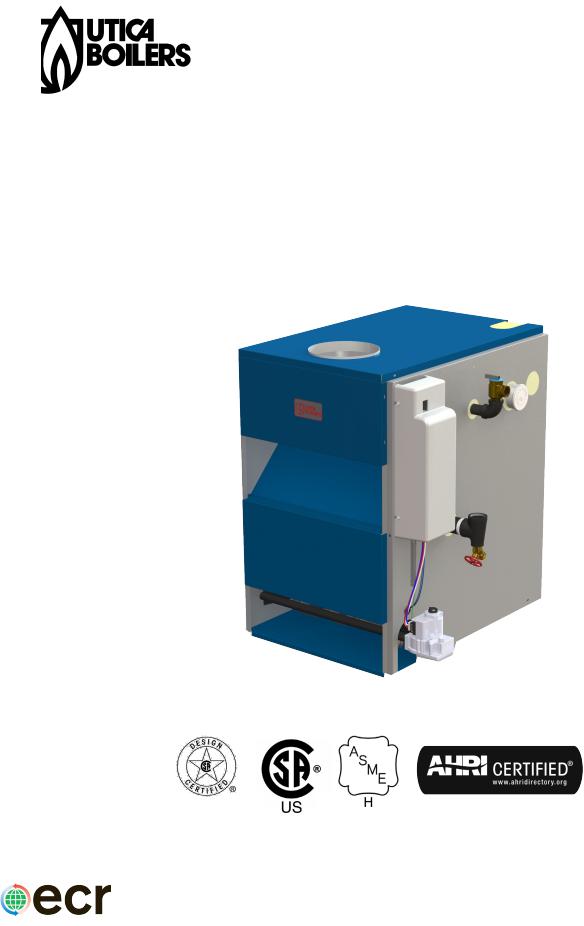
Models
MGB-75J
MGB-100J
MGB-125J
MGB-150J
MGB-170J
MGB-200J
C.S.A. Certified
For Natural Gas Or Propane
An ISO 9001-2008 Certified Company
MGB SERIES II
CAST IRON GAS FIRED BOILERS FOR FORCED HOT WATER
INSTALLATION, OPERATION & MAINTENANCE MANUAL
Tested For 100 psi. ASME
Working Pressure
Manufactured by:
ECR International, Inc.
2201 Dwyer Avenue, Utica NY 13501 web site: www.ecrinternational.com
P/N 240009005, Rev. H [10/2014]
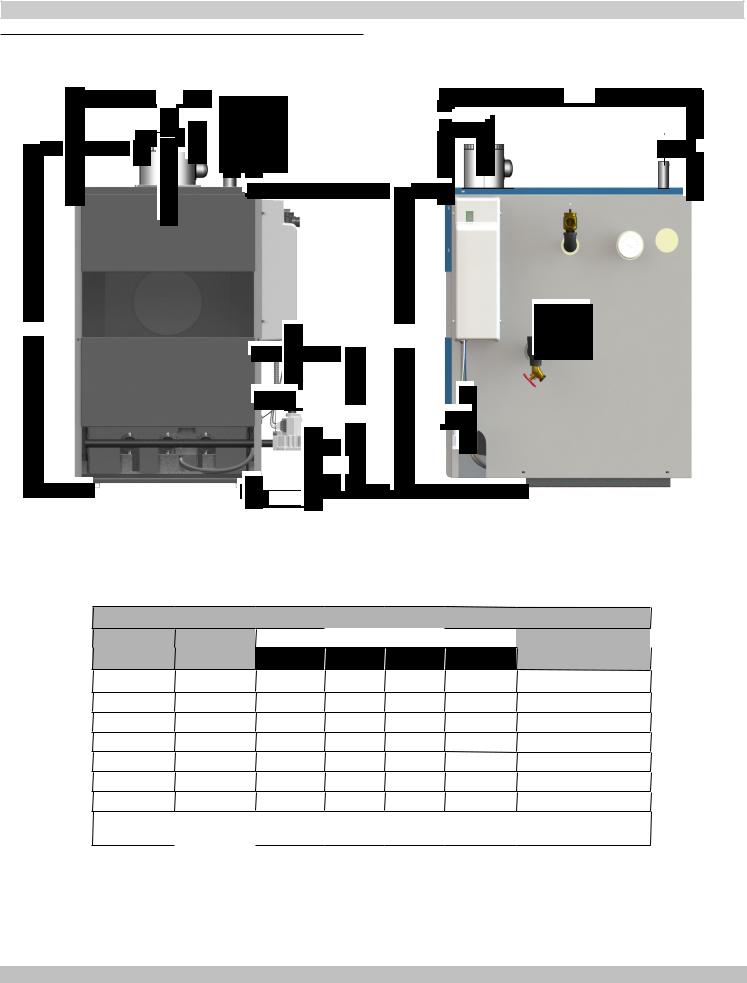
DIMENSIONS
Figure 1 - Dimensions
"A" |
1¼" Supply |
5½" |
|
"B" |
|
|
|
3½" |
|
|
|
|
|
|
|
"D" |
|
|
"C"* |
|
4¼" |
14" |
2½" |
|
|
|
|
|
4¼" |
|
|
|
4½" |
|
|
|
Table 1 - Dimensions |
||
Boiler No. |
Natural Gas |
|
Dimensions |
|
||
|
|
|
|
|||
Inlet* |
A |
B |
C** |
D |
||
|
||||||
|
|
|||||
50 |
½" |
11⅛" |
4" |
30¾" |
36¼" |
|
75 |
½" |
15 |
5" |
30¾" |
37¾" |
|
100 |
½" |
15 |
6" |
30¾" |
37¼" |
|
125 |
½" |
18⅞" |
6" |
30¾" |
37¼" |
|
150 |
½" |
18⅞" |
7" |
30¾" |
37¾" |
|
170 |
½" |
22¾" |
7" |
30¾" |
38¾" |
|
200 |
½" |
22¾" |
8" |
30¾" |
38¾" |
|
*Propane gas inlet, all units, 1/2"
**C is minimum height for low water cutoff installation
27"

 3"
3"
 1¼" Return
1¼" Return
 Pump size Supply &
Pump size Supply & 
Return Tappings
1¼" 1¼" 1¼" 1¼" 1¼" 1¼" 1¼"
2
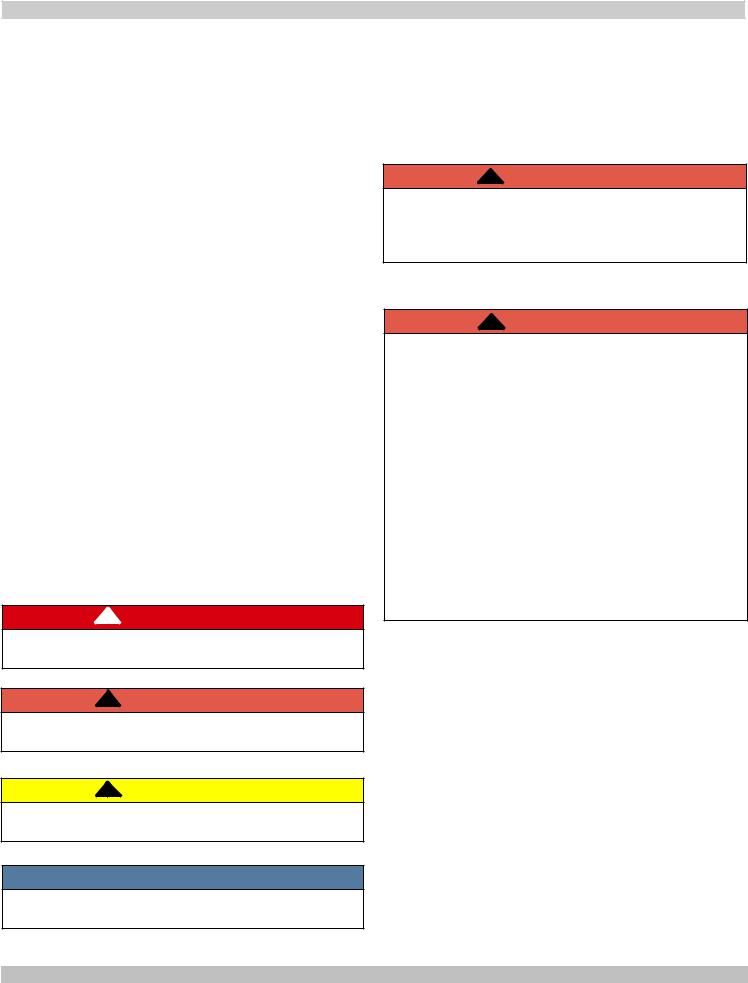
TABLE OF CONTENTS
1 |
- Ratings & Data - Natural Gas & Propane Gas....... |
4 |
|
2 |
- Installation Procedure...................................... |
5 |
|
3 |
- Ventilation & Combustion Air............................. |
6 |
|
4 |
- Connecting Supply and Return Piping................. |
7 |
|
5 |
- Vent Installation............................................ |
12 |
|
6 |
- Vent System Modification............................... |
12 |
|
7 |
- Vent Damper Installation & Instructions........... |
13 |
|
8 |
- Connecting Gas Service.................................. |
14 |
|
9 |
- Electrical Section........................................... |
15 |
|
10 |
- Wiring Diagram .......................................... |
16 |
|
11 |
- Lighting Instructions.................................... |
19 |
|
12 |
- Normal Sequence of Operation...................... |
20 |
|
13 |
- General Instructions.................................... |
20 |
|
14 |
- Checking Gas Input Rate To Boiler................. |
22 |
|
Appendix A - Control Module................................ |
23 |
||
Safety Symbols & Warnings
The following defined symbols are used throughout this manual to notify the reader of potential hazards of varying risk levels.
!DANGER
Indicates a hazardous situation which, if not avoided, WILL result in death or serious injury
KEEP THIS MANUAL NEAR BOILER
RETAIN FOR FUTURE REFERENCE
IMPORTANT: Read the following instructions COMPLETELY before installing!!
! WARNING
Fire, explosion, asphyxiation and electrical shock hazard. Improper installation could result in death or serious injury. Read this manual and understand all requirements before beginning installation.
! WARNING
Keep boiler area clear and free from combustible materials, gasoline and other flammable vapors and liquids.
DO NOT obstruct air openings to the boiler room.
Modification, substitution or elimination of factory equipped, supplied or specified components may result in personal injury or loss of life.
TO THE OWNER - Installation and service of this boiler must be performed by a qualified installer.
TO THE INSTALLER - Leave all instructions with boiler for future reference.
When this product is installed in the Commonwealth of Massachusetts the installation must be performed by a Licensed Plumber or Licensed Gas Fitter.
! WARNING
Indicates a hazardous situation which, if not avoided, could result in death or serious injury.
! CAUTION
Indicates a hazardous situation which, if not avoided, could result in minor or moderate injury.
NOTICE
Used to address practices not related to personal injury.
3
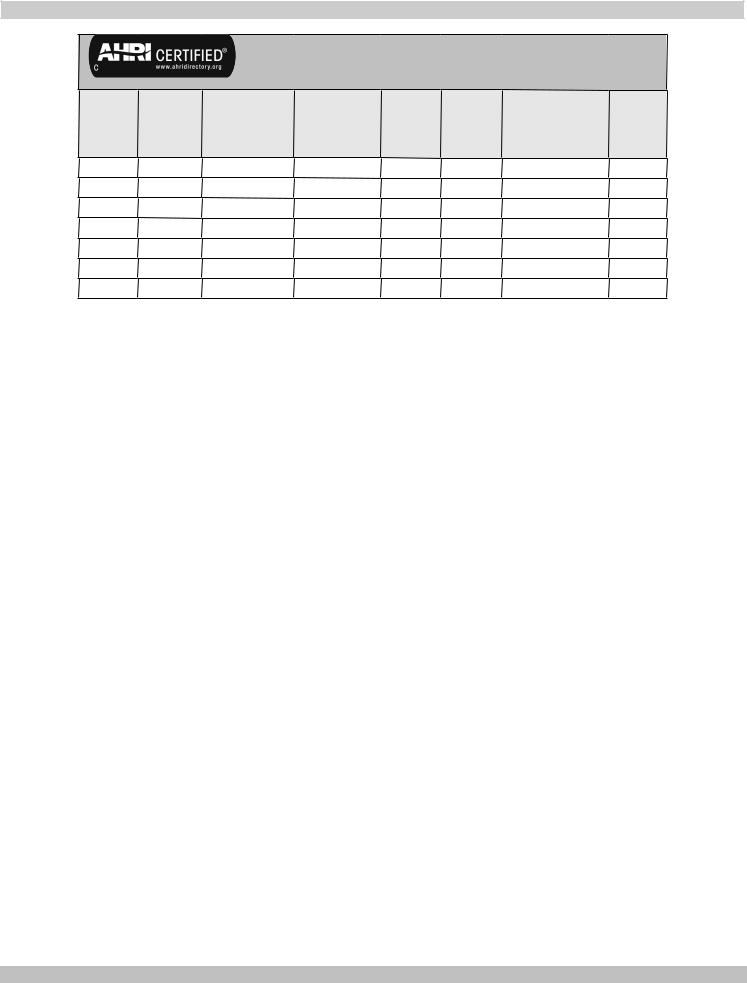
1 - RATINGS & DATA - NATURAL GAS & PROPANE GAS
Table 2 - Ratings and Capacities
|
(1) |
(1) |
Boiler |
Input |
Heating |
No. |
Mbh |
Capacity Mbh |
50J |
50 |
52 |
75J |
75 |
63 |
100J |
100 |
83 |
125J |
125 |
104 |
150J |
150 |
124 |
170J |
170 |
139 |
200J |
200 |
165 |
(2) |
|
|
(3) |
|
Net AHRI |
|
No. |
Recommended |
Water |
Rating Water |
|
of |
Air Cushion |
Content |
Mbh |
AFUE |
Burners |
Tank |
(Gals.) |
36 |
83.5 |
1 |
15 |
2.4 |
55 |
83.1 |
2 |
15 |
4.0 |
72 |
83.0 |
2 |
30 |
4.0 |
90 |
82.0 |
3 |
30 |
5.6 |
108 |
83.0 |
3 |
30 |
5.6 |
121 |
82.0 |
4 |
30 |
7.2 |
143 |
82.0 |
4 |
30 |
7.2 |
EXPLANATORY NOTES
--All boilers are design certified for installation on noncombustible floor.
--For installation on combustible floors use combustible floor kit.
--Recommended chimney height 20 feet. In special cases where conditions permit, chimney height may be reduced to 10 feet. Refer to the latest revision of NFGC part 11.
--Electric service to be 120 Volts, 15 Amps, 60 Hz.
--The MEA number for the this boiler is 19-79-E.
(1) Input rating for sea level to 2,000 ft. (610m) above sea level.
United States, over 2000 ft (610m) above sea level. Reduce input rate 4% for every 1000 ft (304m) above sea level.
(2)Net AHRI Water Ratings shown based on piping and pickup allowance of 1.15. Consult manufacturer before selecting boiler for installations having unusual piping and pickup requirements, such as intermittent system operation, extensive piping systems, etc.
For forced hot water systems where boiler and all piping within area to be heated, boiler may be selected on basis of its heating capacity.
(3)Tank sized for non-ferrous baseboard or radiant panel systems. Increase size for cast iron baseboard and radiation.
STANDARD EQUIPMENT: Boiler Jacket, Cast Iron Boiler Battery, High Limit Control, Intermittent Electric Ignition Pilot System, Vent Damper Relay, Theraltimeter Gauge, Circulator With Return Piping To Boiler, Main Gas Burners, Gas Control (Includes Automatic Gas Valve, Gas Pressure Regulator, Intermittent Pilot, Safety Shutoff, Pilot Flow Adjustment, Pilot Filter), A.S.M.E. Relief Valve, Drain Valve, Spill Switch, Rollout Switch, Combination Gas Control, Automatic Vent Damper. Not Shown Are: Wiring Harness, Thermocouple, Non-linting Safety Pilot.
4
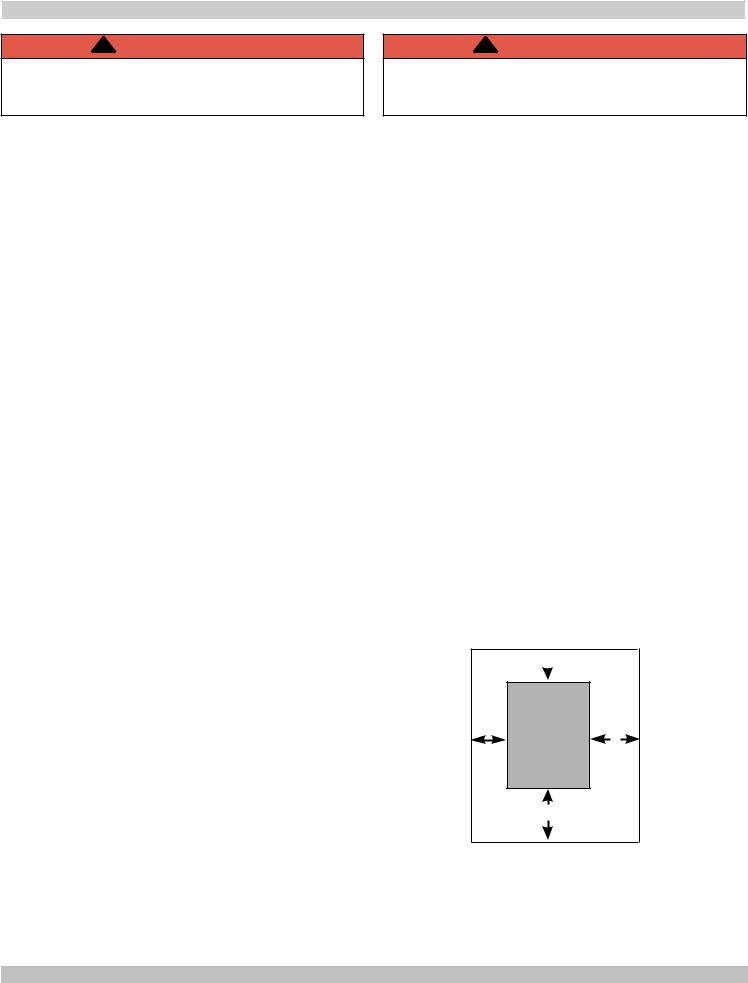
2 - INSTALLATION PROCEDURE
! WARNING
Improper installation, adjustment, alteration, service or maintenance could result in death or serious injury.
1.Installation must conform to the requirements of the authority having jurisdiction or, in the absence of such requirements, to the National Fuel Gas Code, ANSI
Z223.1/NFPA 54.
2.Where required by the authority having jurisdiction, the installation must conform to the Standard for Controls and Safety Devices for Automatically fired Boilers, ANSI/ASME CSD-1.
3.Boiler series is classified as a Category I. Vent installation shall be in accordance with "Venting of Equipment ," of the National Fuel Gas Code, ANSI Z223.1/NFPA 54 or applicable provisions of the local building codes.
4.Boiler has met safe lighting and other performance criteria with the gas manifold and control assembly on the boiler per the latest revision of ANSI Z21.13/CGA
4.9.
5.Install boiler such that gas ignition system components are protected from water (dripping, spraying, rain, etc.) during appliance operation and service, (circulator replacement, condensate trap, control replacement, etc.).
6.Locate boiler on level, solid base as near chimney as possible and centrally located with respect to heat distribution system as practical.
7.Allow 24 inches (610mm ) at front and right side for servicing and cleaning.
8.When installed in utility room, door should be wide enough to allow largest boiler part to enter, or to permit replacement of another appliance such as water heater.
! WARNING
Fire hazard. Do not install boiler on combustible flooring or carpeting. Failure to follow these instructions could result in death or serious injury.
9.FOR INSTALLATION ON NON-COMBUSTIBLE FLOORS ONLY - For installation on combustible flooring special base must be used. (See Repair Parts, Optional Kits Manual). Do not install boiler on carpeting. Minimum clearances to combustible construction are:
TOP..................................... |
18 |
IN. (457mm) |
FRONT.......................................... |
|
ALCOVE * |
FLUE CONNECTOR |
6 |
IN. (152mm) |
REAR.................................... |
4 |
IN. (102mm) |
CONTROL SIDE...................... |
9 |
IN. (229mm) |
OTHER SIDE............................ |
|
3 IN. (76mm) |
HOT WATER PIPING |
Per Local Code |
|
NOTE: Greater clearances for access should supersede fire
protection clearances.
* Definition of Alcove is three sided space with no wall in front of boiler. ANSI standard for alcove is 18 inches from front of appliance to leading edge of side walls as shown below.
Minimum Clearances to Combustible
Construction (as seen from above)
4"
3" BOILER 9"
Front
18" |
5
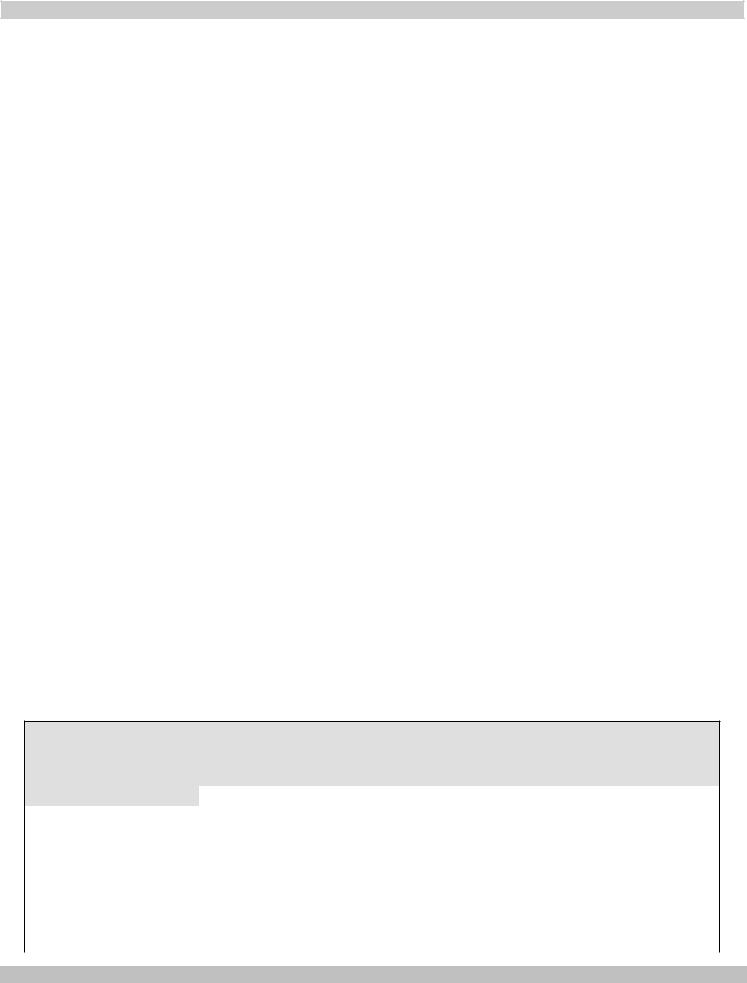
3 - VENTILATION & COMBUSTION AIR
Provide combustion air and ventilation air in accordance with the section “Air for Combustion and Ventilation,” of the National Fuel Gas Code, ANSI Z223.1/NFPA 54 or applicable provisions of local building codes.
Provide make-up air where exhaust fans, clothes dryers, and kitchen ventilation equipment interfere with proper operation.
National Fuel Gas Code recognizes several methods of obtaining adequate ventilation and combustion air. Requirements of the authority having jurisdiction may override these methods.
•Engineered Installations. Must be approved by authority having jurisdictions.
•Mechanical Air Supply. Provide minimum of 0.35 cfm per Mbh for all appliances located within space. Additional requirements where exhaust fans installed. Interlock each appliance to mechanical air supply system to prevent main burner operation when mechanical air supply system not operating.
•All Indoor Air. Calculate minimum volume for all appliances in space. Use a different method if minimum volume not available.
оо Standard Method. Cannot be used if known air infiltration rate is less than 0.40 air changes per hour. See Table 3 for space with boiler only. Use equation for multiple appliances.
Volume ≥ 50 ft3 x Total Input [Mbh]
оо Known Air Infiltration Rate. See Table 3 for space with boiler only. Use equation for multiple appliances. Do not use an air infiltration rate (ACH) greater than 0.60.
Volume ≥ 21 ft3/ACH x Total Input [Mbh]
оо Refer to National Fuel Gas Code for opening requirements between connection indoor spaces.
•All Outdoor Air. Provide permanent opening(s) communicating directly or by ducts with outdoors.
оо Two Permanent Opening Method. Provide opening commencing within 12 inches of top and second opening commencing within 12 inches of bottom enclosure.
Direct communication with outdoors or communicating through vertical ducts. Provide minimum free area of 1 in2 per 4 Mbh of total input rating of all appliances in enclosure.
Communicating through horizontal ducts. Provide minimum free area of 1 in2 per 2 Mbh of total input rating of all appliances in enclosure.
оо One Permanent Opening Method. Provide opening commencing within 12 inches of top of enclosure. Provide minimum clearance of 1 inch on sides and back and 6 inches on front of boiler (does not supersede clearance to combustible materials).
•Refer to National Fuel Gas Code for additional requirements for louvers, grilles, screens and air ducts.
•Combination Indoor and Outdoor Air. Refer to National Fuel Gas Code for application information.
Table 3 - Space With Boiler Only
|
|
|
Room Cubic Feet Volume |
|
|
|||
Input Mbh |
Standard |
Known Air Infiltration Rate Method (ACH - Air Changes Per Hour) |
||||||
Method |
0.1 |
0.2 |
0.3 |
0.4 |
0.5 |
0.6 |
||
|
||||||||
50 |
2500 |
10500 |
5250 |
3500 |
2625 |
2100 |
1750 |
|
75 |
3750 |
15750 |
7875 |
5250 |
3938 |
3150 |
2625 |
|
100 |
5000 |
21000 |
10500 |
7000 |
5250 |
4200 |
3500 |
|
125 |
6250 |
26250 |
13125 |
8750 |
6563 |
5250 |
4375 |
|
150 |
7500 |
31500 |
15750 |
10500 |
7875 |
6300 |
5250 |
|
170 |
8500 |
35700 |
17850 |
11900 |
8925 |
7140 |
5950 |
|
200 |
10000 |
42000 |
21000 |
14000 |
10500 |
8400 |
7000 |
|
6
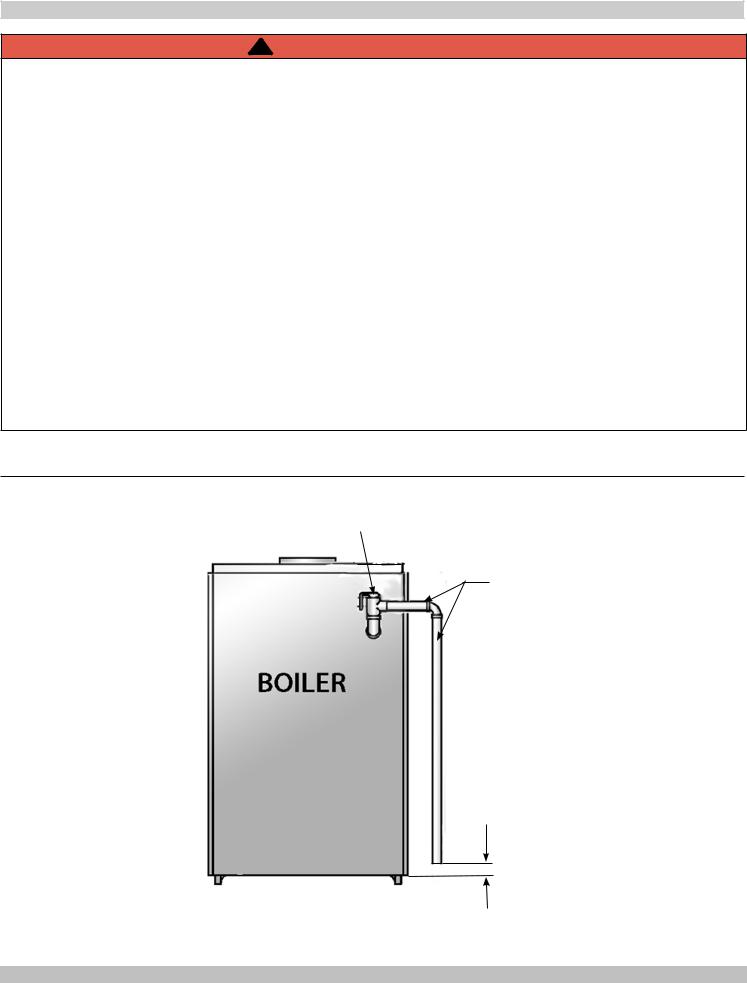
4 - CONNECTING SUPPLY AND RETURN PIPING
!WARNING
Burn or Scald Hazard. Discharge line shall be installed to relief valve outlet connection to avoid burns, scalding, or water damage due to discharge of steam and/or hot water during operation.
Discharge line shall:
•connect to relief valve outlet and piped down to safe point of disposal. Check local codes for maximum distance from floor or allowable safe point of discharge.
•be of pipe size equal to or greater than that of the relief valve outlet over the entire length of discharge line;
•have no intervening shutoff valve between safety relief valve and discharge to atmosphere (do not plug or place any obstruction in discharge line.
•terminate freely to atmosphere where any discharge will be clearly visible and at no risk of freezing;
•allow complete drainage of the valve and the discharge line;
•be independently supported and securely anchored to avoid applied stress on the relief valve;
•be as short and straight as possible;
•terminate with plain end (not threaded);
•be constructed of material suitable for exposure to temperatures of 375° F (191°C); or greater.
Refer to local codes and appropriate ASME Boiler and Pressure Vessel Code for additional installation requirements.
Figure 2 - Safety Relief Valve
RELIEF VALVE
DISCHARGE
LINE
Check local codes for maximum distance from floor or allowable safe point of
discharge.
7
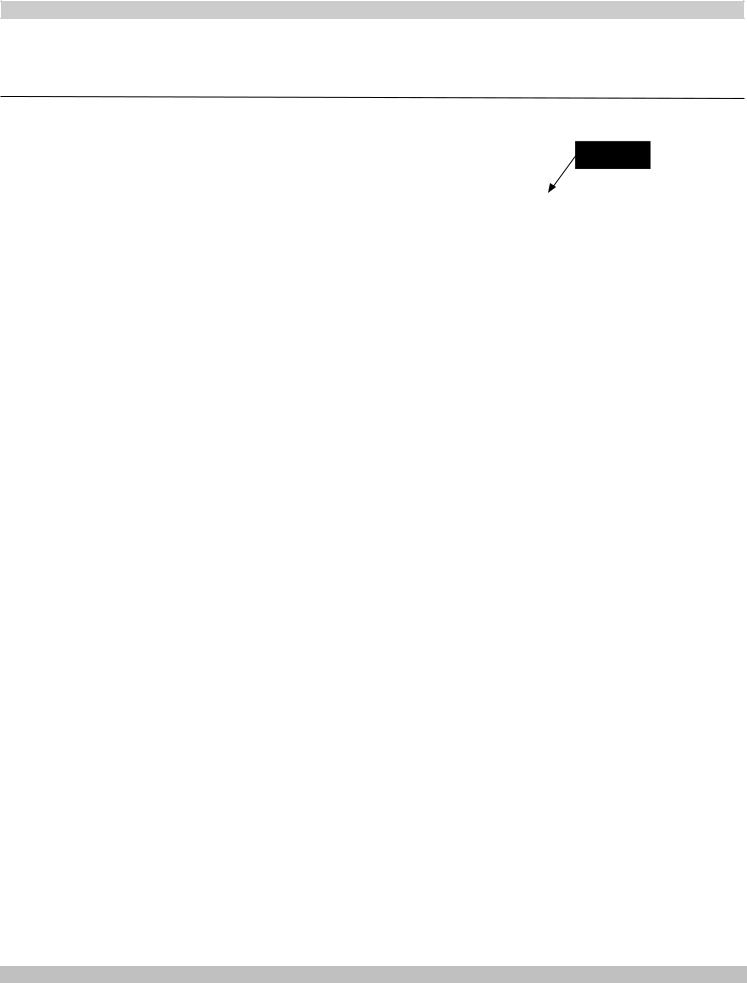
4 - CONNECTING SUPPLY AND RETURN PIPING
Circulators in following illustrations are mounted on system supply side, mounting on system return side is also acceptable practice.
Figure 3 - Circulators Mounted on Supply System, Boiler Used In Configuration with Chiller System.
See Special Conditions, Page 9
1.Boiler used in connection with refrigeration system, install so chilled medium is piped in parallel with boiler with appropriate valves to prevent chilled medium from entering boiler. See Figure 2.
2.Boiler piping system of hot water boiler connected to heating coils located in air handling units where they may be exposed to refrigerated air circulation must be equipped with flow control valves or other automatic means to prevent gravity circulation of boiler water during cooling cycle.
3.Hot water boilers installed above radiation level or as required by authority having jurisdiction must be provided with low water cut-off device.
4.Boiler connected to heating system utilizing multiple zoned circulators, each circulator must be supplied with flow control valve to prevent gravity circulation.
5.Hot water boilers and system must be filled with water and maintained to minimum pressure of 12 psi.
6.For Low Water Cutoff, see Figure 1 for minimum height. Use Kit #240010831. Follow instruction enclosed with the kit. Other LWCO's for their manufacture specific instructions.
7.Bypass piping is optional which gives ability to adjust supply boiler water temperature to fit system or condition of installation. This method of piping,
however, is not typically required for baseboard heating systems. Typical installations where bypass piping is used are as follows:
A.This method is used to protect boilers from condensation forming due to low temperature return water. Generally noticed in large converted gravity systems or other large water volume systems. Figures 4 and 5.
B.These methods are used to protect systems using radiant panels and material they are encased in from high temperature supply water from boiler and protect boiler from condensation.
NOTE#1: When using bypass piping, adjust valves V1 & V2 until desired system temperature is obtained. See Figure 5, page 9.
NOTE#2: Bypass loop must be same size piping as supply and return piping.
8
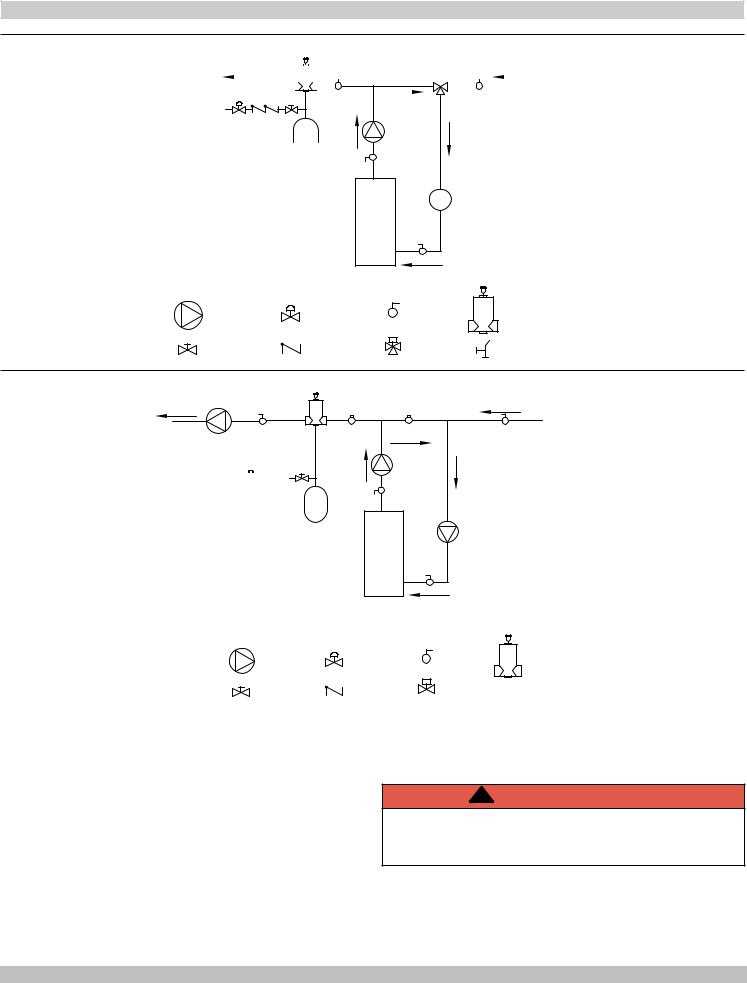
4 - CONNECTING SUPPLY AND RETURN PIPING
Figure 4 - Bypass Piping With Mixing Valve
TO SYSTEM |
|
|
|
|
|
|
|
|
|
|
|
|
|
|
FROM SYSTEM |
||||||
|
|
|
|
|
|
|
|
|
|
|
|
|
|
|
|
|
|
|
|
|
|
WATER INLET
EXPANSION
TANK
BOILER  ALTERNATE
ALTERNATE
CIRCULATOR
LOCATION
CIRCULATOR |
PRESSURE |
BALL VALVE |
AIR SEPARATOR |
|
|
REDUCER VALVE |
|
|
|
SHUT-OFF |
CHECK VALVE |
3 WAY MIXING |
HOSE BIB |
|
VALVE |
||||
|
VALVE |
|||
|
|
|
Figure 5 - Bypass Piping - Fixed Low Temp Only With Zone Valve
TO SYSTEM |
FROM SYSTEM |
|
V1 V2
SYSTEM
CIRCULATOR
WATER INLET 






EXPANSION
TANK BOILER ALTERNATE
CIRCULATOR
LOCATION
CIRCULATOR |
PRESSURE |
BALL VALVE |
AIR SEPARATOR |
|
REDUCER VALVE |
|
|
SHUT-OFF |
CHECK VALVE |
ZONE VALVE |
|
VALVE |
|
|
|
|
|
|
8.Installation using circulators and zone valves are shown in Figures 6 through 9. For further piping information refer to AHRI Installation and Piping Guide.
!WARNING
Burn and scald hazard. Safety relief valve could discharge steam or hot water during operation. Install discharge piping per these instructions.
9.Install discharge piping from safety relief valve. See Warning, Page 7.
9
